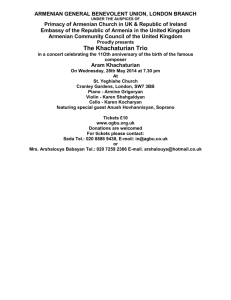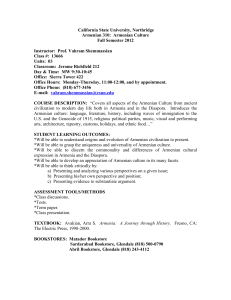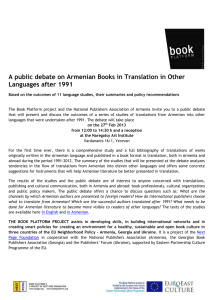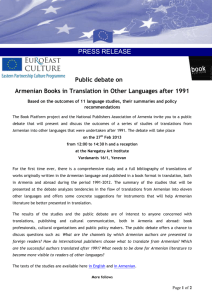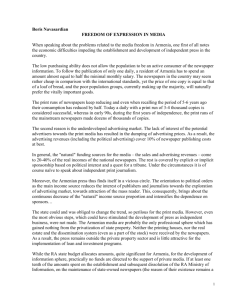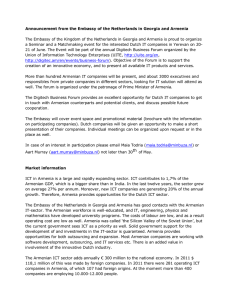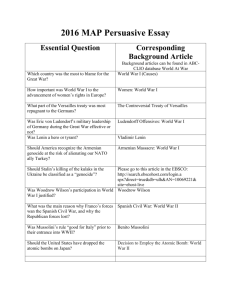The Armenian Language
advertisement
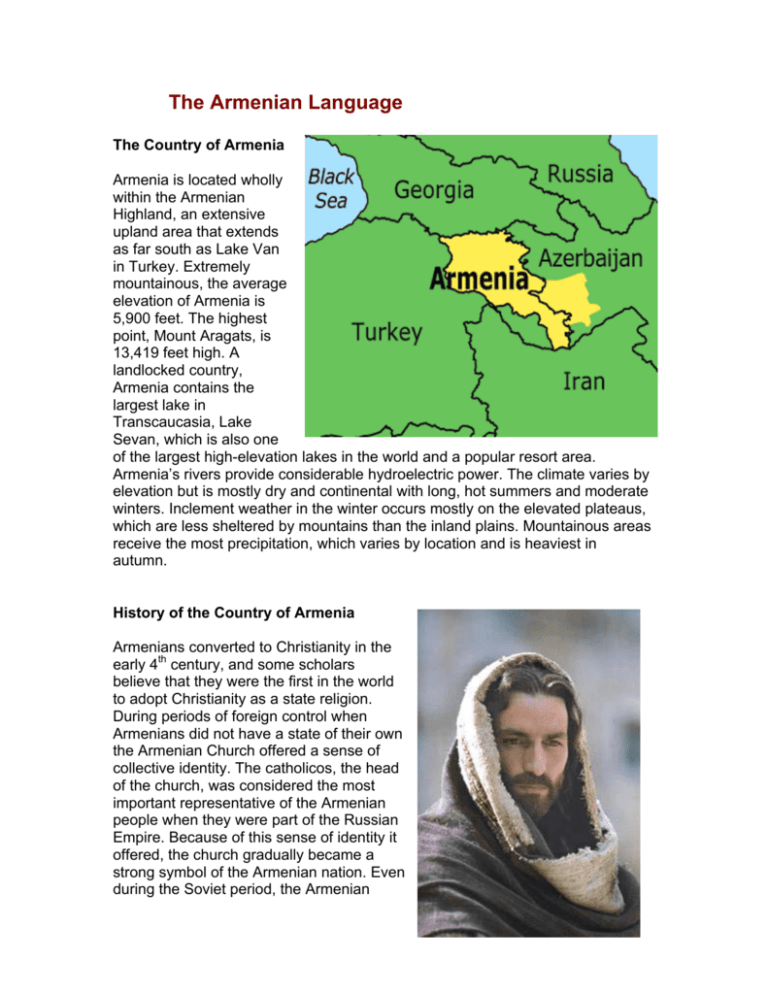
The Armenian Language The Country of Armenia Armenia is located wholly within the Armenian Highland, an extensive upland area that extends as far south as Lake Van in Turkey. Extremely mountainous, the average elevation of Armenia is 5,900 feet. The highest point, Mount Aragats, is 13,419 feet high. A landlocked country, Armenia contains the largest lake in Transcaucasia, Lake Sevan, which is also one of the largest high-elevation lakes in the world and a popular resort area. Armenia’s rivers provide considerable hydroelectric power. The climate varies by elevation but is mostly dry and continental with long, hot summers and moderate winters. Inclement weather in the winter occurs mostly on the elevated plateaus, which are less sheltered by mountains than the inland plains. Mountainous areas receive the most precipitation, which varies by location and is heaviest in autumn. History of the Country of Armenia Armenians converted to Christianity in the early 4th century, and some scholars believe that they were the first in the world to adopt Christianity as a state religion. During periods of foreign control when Armenians did not have a state of their own the Armenian Church offered a sense of collective identity. The catholicos, the head of the church, was considered the most important representative of the Armenian people when they were part of the Russian Empire. Because of this sense of identity it offered, the church gradually became a strong symbol of the Armenian nation. Even during the Soviet period, the Armenian Church was allowed to continue as the national church even though the Communists were officially atheistic. Clergy who supported nationalist groups were not allowed to hold power within the church, however Christianity remains the country’s predominant religion with 94 percent of the population belonging to the Armenian Apostolic or Orthodox Church. Among the ethnic minorities in Armenia, there are Russian Orthodox Christians, Protestants, and Muslims. Government Armenia declared independence on September 23, 1991, and became an independent state when the USSR disbanded in December. Fighting between mostly Christian Armenia and mostly Muslim Azerbaijan over an enclave in Azerbaijan, called Nagorno-Karabakh that has a majority population of ethnic Armenians, escalated in 1992 and continued through 1993. Armenian forces defeated the Azerbaijani army in several confrontations, and Armenia gained control of the region by August of 1993. A ceasefire agreement was reached in May 1994 with Armenia retaining control of the enclave.i The Armenian Language Today, five to six million people speak Armenian (Grimes 1992), although the total population of the Republic of Armenia is only 3.5 million (ninety three percent of whom are ethnic Armenian). Thus, nearly half of Armenian speakers today live outside their historic homeland, primarily in Iran (370,000), Syria (299,000), Lebanon (235,000), Egypt (100,000), and the United States (175,000). Smaller communities, fewer than 40,000, are found in Canada, Cyprus, Greece, India, Israel, and Jordan. Somewhat larger communities, between 40,000 and 70,000 speakers, live in Turkey, France, and Iraq. Enclaves of speakers also reside in Georgia and Azerbaijan, especially the Nagorno Karabakh region (CIA 1992). Haieren and Ashkhari are Armenian terms for the language, although the latter is somewhat erudite. History – Language related The scattered population of Armenian speakers--the diaspora--is the result of several historically significant events. During World War I, Armenian speakers in Turkey suffered persecution and then genocide in 1915. From 1918 to 1920, those who resisted the Turks attempted to create an independent Armenian Republic but ultimately were unsuccessful. Historic Armenia was then divided up among the USSR, Turkey, and Iran while numerous Armenians fled to other parts of the world. These Armenians are the primary speakers of the West Armenian dialect. The Armenians who settled in Armenia and Iran were influenced by the USSR. By 1923, all the political power in Armenia was in the hands of the Soviet government and the East Armenian dialect was subsequently influenced by two sets of Soviet orthographic reforms.ii Language Variation Two standard dialects exist. Eastern Armenian is used in Armenia and in enclaves in Azerbaijan and Iran. Armenians in Istanbul, Lebanon, Egypt, other parts of the diaspora, and formerly in eastern Turkey use Western Armenian. Eastern Armenian has been influenced by two sets of Russian reforms and differs orthographically from Western Armenian; there are also phonological differences. Many regional dialect variations exist, e.g., Yerevan, Tbilisi, Karabagh, Istanbul (Djahukian 1986). Some local dialects are so different from both standard forms of the language that speakers of the standard forms have difficulty in understanding local dialects (Greppin and Khachaturian 1986). Otherwise, dialect differences are no greater than dialect differences within American English. Orthography The Armenian alphabet was derived primarily from the Greek alphabet in the fifth century and consists of thirty-eight (originally thirty six) letters. Although foreign influences have greatly changed the Armenian language Armenian's script is easily distinguished from Persian and Arabic writing. Linguistic Sketch The sound system of Armenian is atypical of Indo-European languages in that it has ejective sounds. Ejectives are sounds made by using the vocal cords instead of the lungs to push out air. It is probable that these sounds were borrowed from neighboring Caucasian languages. Words are normally assigned word final stress. Role in Society Armenian is the official language in Armenia and is used in schools and by the media. Armenians of the diaspora have gained renewed interest in their homeland as a result of the Armenian revolution and the establishment of the Republic of Armenia. Although many Armenians of the diaspora do not intend to return to their Armenian homeland, they consider continued use of the language of critical importance to the maintenance of a unified Armenian sense of history and identity. Because many second-generation Armenian immigrants in the United States have lost proficiency in their native language, attempts are being made to preserve their cultural heritage. Thus, the Armenian community in the United States has recently published many books that are intended to reintroduce Armenians to their mother tongue, generally the West Armenian dialect. In addition to textbooks, Armenian language newspapers are printed in Boston, Fresno, and New York. Thus the Armenian language learner in the United States has a rich diversity of language materials and cultural resources to draw from. i ii AGWM World Focus, WFARME~1.DOC http://www.lmp.ucla.edu/profiles/profa02.htm Graohics used: Armenia map, http://www.lmp.ucla.edu/profiles/profa02.htm Biblical looking, http://img.coxnewsweb.com/B/08/80/75/image_475808.jpg Armenian Woman, http://www.anahit.am/gr/splash.gif Group of older women, http://w3.physics.uiuc.edu/~danagoul/peop2.jpg Child with horse, http://w3.physics.uiuc.edu/~danagoul/child10.jpg Armenian church, http://www.bravosolutions.com/ecards/armenian_church.jpg
